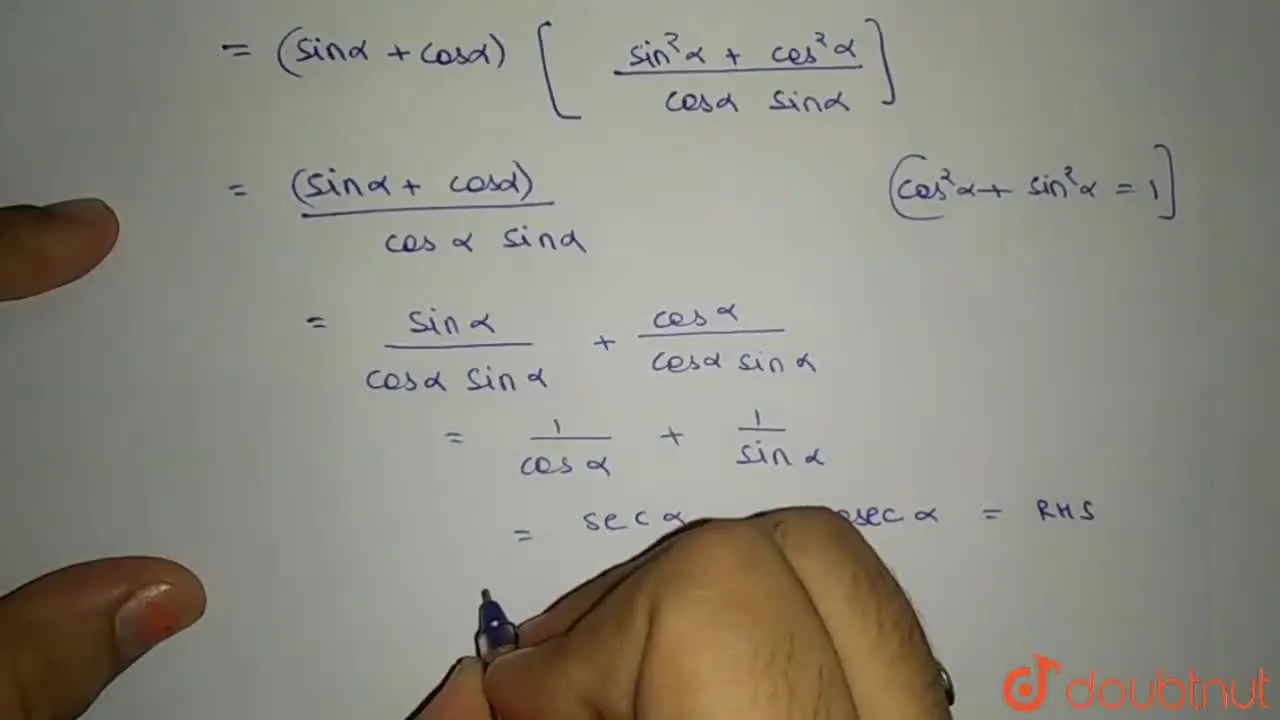Prove that (sinα+cosα)(tanα+cotα)=secα+cosecα
Step by step video & image solution for Prove that (sinalpha+cosalpha)(tanalpha+cotalpha)=secalpha+"cosec"alpha by Maths experts to help you in doubts & scoring excellent marks in Class 10 exams.
Related Playlists
- BOOK - CBSE COMPLEMENTARY MATERIALCHAPTER - INTRODUCTION TO TRIGONOMETRYEXERCISE - PRACTICS-TEST (SECTION-C)2videos
INTRODUCTION TO TRIGONOMETRY
- BOOK - CBSE COMPLEMENTARY MATERIALCHAPTER - INTRODUCTION TO TRIGONOMETRYEXERCISE - PRACTICS-TEST (SECTION-D)1videos
INTRODUCTION TO TRIGONOMETRY
- BOOK - CBSE COMPLEMENTARY MATERIALCHAPTER - INTRODUCTION TO TRIGONOMETRYEXERCISE - PRACTICS-TEST (SECTION-A)4videos
INTRODUCTION TO TRIGONOMETRY
- BOOK - CBSE COMPLEMENTARY MATERIALCHAPTER - CONSTRUCTIONSEXERCISE - (PRACTICE-TEST) SECTION-C1videos
CONSTRUCTIONS
- BOOK - CBSE COMPLEMENTARY MATERIALCHAPTER - PAIR OF LINEAR EQUATIONS IN TWO VARIABLESEXERCISE - PRACTICE-TEST (SECTION-D)1videos
PAIR OF LINEAR EQUATIONS IN TWO VARIABLES
Similar Questions
(sinα+cosα)(tanα+cotα)=secα+cosecα
View SolutionProve that : (sinα+cosα)(tanα+cotα)=secα+cosecα.
View SolutionProve that 1−cosαsinα=tan(α2)
View SolutionIf tanθ=sinα−cosαsinα+cosα, then sinα+cosαandsinα−cosα are equal to
View Solution(sinα+secα)2+(cosα+cosecα)2=(K+secαcosecα)2, then K = ?
View SolutionIf tanθ=sinα−cosαsinα+cosα, then (A) sinα−cosα=±√2sinθ (B) sinα+cosα=±√2cosθ (C) cos2θ=sin2α (D) sin2θ+cos2α=0
View SolutionProve that : 1+cot2α1+cosecα=cesecα
View SolutionA square of side a lies above the x-axis and has one vertex at the origin. The side passing through the origin makes an angle α(0<α<π4) with the positive direction of x-axis. equation its diagonal not passing through origin is (a) y(cosα+sinα)+x(sinα−cosα)=α(b)y(cosα+sinα)+x(sinα+cosα)=α(c)y(cosα+sinα)+x(cosα−sinα)=α(d)y(cosα−sinα)−x(sinα−cosα)=α
View SolutionIf ∫sinxsin(x−α)dx=Ax+Blogsin(x−α)+C, then value of (A,B) is (A) (−sinα,cosα) (B) (−cosα,sinα) (C) (sinα,cosα) (D) (cosα,sinα)
View SolutionIf tanθ=sinα−cosαsinα+cosα then show that sinα+cosα=√2cosθ.
View Solution


